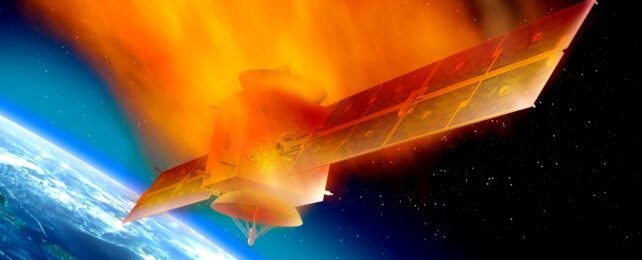Elon Musk's SpaceX has announced it will dispose of 100 Starlink satellites over the next six months, after it discovered a design flaw that may cause them to fail. Rather than risk posing a threat to other spacecraft, SpaceX will "de-orbit" these satellites to burn up in the atmosphere.
But atmospheric scientists are increasingly concerned that this sort of apparent fly-tipping by the space sector will cause further climate change down on Earth.
One team recently, and unexpectedly, found potential ozone-depleting metals from spacecraft in the stratosphere, the atmospheric layer where the ozone layer is formed.
The relative "low earth orbit" where satellites monitoring Earth's ecosystems are found is increasingly congested – Starlink alone has more than 5,000 spacecraft in orbit.
Clearing debris is therefore a priority for the space sector. Newly launched spacecraft must also be removed from orbit within 25 years (the US recently implemented a stricter five-year rule) either by moving upwards to a so-called "graveyard orbit" or down into the Earth's atmosphere.
Lower orbiting satellites are usually designed to use any remaining fuel and the pull of the Earth's gravity to re-enter the atmosphere. In a controlled reentry, the spacecraft enters the atmosphere at a pre-set time to land in the most remote part of the Pacific Ocean at Point Nemo (aka the spacecraft cemetery). In an uncontrolled re-entry, spacecraft are left to follow a "natural demise" and burn up in the atmosphere.
Nasa and the European Space Agency promote this form of disposal as part of a design philosophy called "design for demise". It is an environmental challenge to build, launch and operate a satellite robust enough to function in the hostility of space yet also able to break up and burn up easily on re-entry to avoid dangerous debris reaching the Earth's surface. It's still a work in progress.
Satellite operators must prove their design and re-entry plans have a low "human-hit" rate before they are awarded a license. But there is limited concern regarding the impact on Earth's upper atmosphere during the re-entry stage. This is not an oversight.
Initially, neither the space sector nor the astrophysics community considered burning up satellites on re-entry to be a serious environmental threat – to the atmosphere, at least.
After all, the number of spacecraft particles released is small when compared with 440 tonnes of meteoroids that enter the atmosphere daily, along with volcanic ash and human-made pollution from industrial processes on Earth.
Bad news for the ozone layer?
So are atmospheric climate scientists overreacting to the presence of spacecraft particles in the atmosphere? Their concerns draw on 40 years of research into the cause of the ozone holes above the south and north poles, that were first widely observed in the 1980s.
Today, they now know that ozone loss is caused by human-made industrial gases, which combine with natural and very high altitude polar stratospheric clouds or mother of pearl clouds. The surfaces of these ethereal clouds act as catalysts, turning benign chemicals into more active forms that can rapidly destroy ozone.
Dan Cziczo is an atmospheric scientist at Purdue University in the US, and a co-author of the recent study that found ozone depleting substances in the stratosphere. He explains to me that the question is whether the new particles from spacecraft will help the formation of these clouds and lead to ozone loss at a time when the Earth's atmosphere is just beginning to recover.
Of more concern to atmospheric scientists such as Cziczo is that only a few new particles could create more of these types of polar clouds – not only at the upper atmosphere, but also in the lower atmosphere, where cirrus clouds form.
Cirrus clouds are the thin, wispy ice clouds you might spot high in the sky, above six kilometres. They tend to let heat from the sun pass through but then trap it on the way out, so in theory more cirrus clouds could add extra global warming on top of what we are already seeing from greenhouse gases. But this is uncertain and still being studied.
Cziczo also explains that from anecdotal evidence we know that the high-altitude clouds above the poles are changing – but we don't know yet what is causing this change. Is it natural particles such as meteoroids or volcanic debris, or unnatural particles from spacecrafts? This is what we need to know.
Concerned, but not certain
So how do we answer this question? We have some research from atmospheric scientists, spacecraft builders and astrophysicists, but it's not rigorous or focused enough to make informed decisions on which direction to take. Some astrophysicists claim that alumina (aluminium oxide) particles from spacecraft will cause chemical reactions in the atmosphere that will likely trigger ozone destruction.
Atmospheric scientists who study this topic in detail have not made this jump as there isn't enough scientific evidence. We know particles from spacecraft are in the stratosphere. But what this means for the ozone layer or the climate is still unknown.
It is tempting to overstate research findings to garner more support. But this is the path to research hell – and deniers will use poor findings at a later date to discredit the research. We also don't want to use populist opinions.
But we've also learnt that if we wait until indisputable evidence is available, it may be too late, as with the loss of ozone. It's a constant dilemma.![]()
Fionagh Thomson, Senior Research Fellow (visual ethnographer), Durham University
This article is republished from The Conversation under a Creative Commons license. Read the original article.
